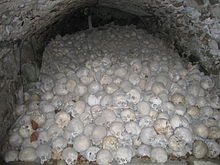Chammünster
|
Chammünster
City of Cham
Coordinates: 49 ° 12 ′ 39 ″ N , 12 ° 41 ′ 38 ″ E
|
||
|---|---|---|
| Height : | 376 m | |
| Incorporation : | May 1, 1978 | |
| Postal code : | 93413 | |
| Area code : | 09971 | |
|
Location of Chammünster in Bavaria |
||
Chammünster is a district of the district town of Cham . The place played an important role in the Christianization of the Bavarian Forest and the Bohemian border region in the Middle Ages.
history
740 gives Duke Tassilo III. from Bavaria to the Benedictines from the monastery Sankt Emmeram in Regensburg Land in the Mark Chamb. They set up a cell as a mission base for the Bohemian border area.
Around the year 910 the cell was probably destroyed by the Hungarians. In 975, as a result of the separation of the bishop's chair and St. Emmeram monastery by Wolfgang von Regensburg, the Chammünster cell was assigned to the bishop. Chammünster becomes the original parish of the Upper Bavarian Forest .
In the 14th century the parish seat was moved to the city of Cham; the settlement continues to develop independently. According to the farm diary of 1760, the community counts 52 properties and names among them taverns, taschner, farrier, baker and butcher.
When tax districts were introduced in the course of the administrative reform in the Kingdom of Bavaria , the Chammünster tax district was formed in 1808/1809 from the communities of Chammünster with Lamberg, Chameregg, Herwalting with Steinklammer, Hof, Prüdensdorf, Schlondorf, Staning and Wölsting with Walmering.
When the community was formed according to the community edict of 1818, Chammünster was classified as a direct regional court.
In 1946 the former municipalities of Chameregg, Gutmaning and Hof were incorporated. Schachendorf and Vilzing as well as part of Haderstadl followed on July 1, 1972. On May 1, 1978, it was incorporated into the city of Cham. In 1989, Chammünster became the seat of a Catholic parish again.
Culture and sights
Buildings
Catholic Parish Church of the Assumption
The three-aisled pseudo - basilica was built in the 15th century, incorporating the tower and choir of the early Gothic predecessor building. The two towers of the parish church are depicted on the coat of arms of the Cham district. The fragments of the frescoes from the time of construction, which were uncovered in 1912, are significant . It is the depiction of the legend of the three living and three dead kings , the coats of arms of the Chamerau and Göttlingers and a protective cloak Madonna. The two Romanesque baptismal fonts and the sandstone pulpit from the 15th century are worth mentioning .
From the Middle Ages to modern times, Chammünster was a popular burial place for the regional nobility and the citizens of Cham. About 100 grave slabs, epitaphs and death shields have been preserved, many of them from the 14th and 15th centuries. In the cemetery around the church and in the parish church there are also numerous wrought-iron crosses from the Baroque period to the Biedermeier period.
The name Marienmünster, which probably refers to the original Benedictine cell, is also common.
St. Anne's Chapel
The St Anna Chapel was built between 1367 and 1393 as a burial place for the Knights of Chamerau. The Gothic complex was changed in the 18th century. During the renovation work at the end of the 1980s, an apostolic cross was uncovered from the Gothic painting . The chapel also serves as a museum and houses u. a. the oldest bell (13th century) in the Diocese of Regensburg , a Carolingian column, architectural fragments of the destroyed Katharinen Chapel and a collection of wrought iron grave crosses. The Mannerist cross shown is an absolutely unique specimen among experts .
Karner
The modern morgue in the cemetery was built over the vaults of the former St. Katharinen Chapel. The upper floor of the Romanesque building was destroyed by the Calvinists in the 16th century. An unknown number of bones and about 5000 skulls from the Middle Ages are neatly piled up in the vaults. It is the only Karner in a wide area that still contains human bones.
Biendl house
The oldest secular building in Chammünster was built in the 17th century with the inclusion of late Gothic buildings. The legend says that stones from the nearby Chameregg castle ruins were used. The two-storey saddle roof construction shows the Egerland influence with its half-timbered gable .
sons and daughters of the town
- Werner Perlinger (* 1942), local history researcher
- Leony (born 1997), pop singer
literature
- Hoffmann, Hager (ed.): The art monuments of the Kingdom of Bavaria. Volume VI. District Office Cham. Oldenbourg Verlag, 1906, pp. 46-87.
- Franz X Hebauer: Chammünster: Parish Church of the Assumption. Schnell & Steiner Verlag, 2002.
- Georg Dehio: Handbook of the German art monuments. Volume 5. Regensburg and the Upper Palatinate. Revised by Jolanda Drexler and Achim Hubel. Deutscher Kunstverlag, 1991, p. 98 ff.
Individual evidence
- ^ Max Piendl: Historical Atlas of Bavaria. The Cham district court. Oldenbourg Verlag, 1955, p. 17. (Altbayern series 1, booklet 8)
- ^ Wilhelm Volkert (ed.): Handbook of Bavarian offices, communities and courts 1799–1980 . CH Beck, Munich 1983, ISBN 3-406-09669-7 , p. 439 .
- ^ Federal Statistical Office (ed.): Historical municipality directory for the Federal Republic of Germany. Name, border and key number changes in municipalities, counties and administrative districts from May 27, 1970 to December 31, 1982 . W. Kohlhammer GmbH, Stuttgart and Mainz 1983, ISBN 3-17-003263-1 , p. 644 .
Web links
- Rediscovery of the Karner on waldherz.com
- Aerial views of the basilica




